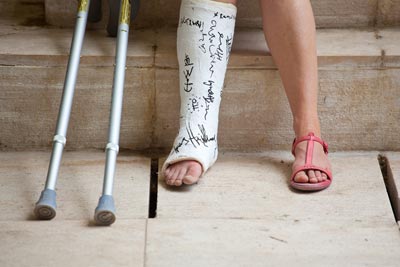
Ankle Sprains
Spring is in the air and people are spending more time outdoors. With increased activities come increased injuries. A sprained ankle is a very common injury, affecting about 25,000 people daily. Ankle sprains happen to athletes and non-athletes and people of all ages. Though more common in active individuals, it can happen with everyday activities such as going down steps or stepping off the curb.
Ankle sprain happens when the foot twists or turns beyond its normal motions causing the ligaments to stretch beyond their normal range. The ligaments of the foot and ankle hold the bones and joints in position and protect the joints from abnormal movements. Ligaments are elastic structures, usually stretching with activities and then returning to their normal positions. When a ligament is forced to stretch beyond its normal range, a sprain occurs. In severe cases, complete or partial tears can occur.
Simple ankles sprains can be treated by rest, ice, supportive bracing and immobilization and usually heal within three weeks in most cases. There are, however, more serious injuries that can occur along with an ankle sprain that might be missed since the initial symptoms are similar. These include avulsion fractures of the foot and ankle bones, fractures of the fifth metatarsal bone, peroneal tendon injury and even damage to the joint surfaces.
A comprehensive exam including x-ray, ultrasound or even MRI, when appropriate, can help make the accurate diagnoses and treatment course. While you might be able to walk after a simple ankle sprain, the most often missed injuries require non-weightbearing immediately. Making the right diagnoses and having the right treatment will lead to adequate healing and quickest return to normal activities. Inappropriate care of your injury may result in long or incomplete recovery often leading to chronic pain and swelling, instability and repeat injuries. Arthroscopy or reconstructive surgery might be necessary for those suffering from these symptoms if conservative treatments and Physical Therapy are not effective.
So, next time you hurt your foot or ankle, or have an ankle sprain that is not improving, it might be more than a simple sprain. Have a podiatrist specialized in foot and ankle trauma examine you and provide you with appropriate treatment.


